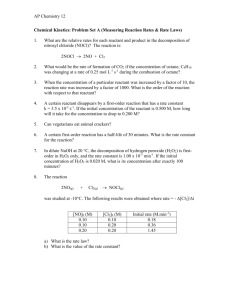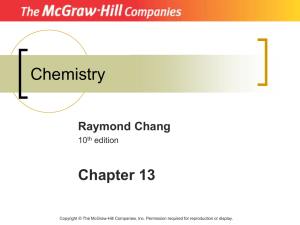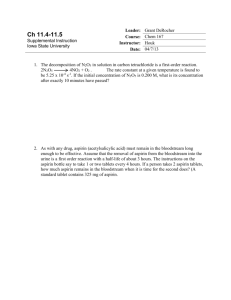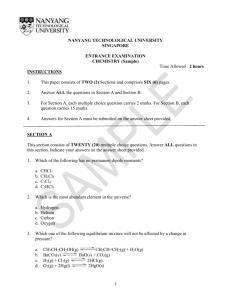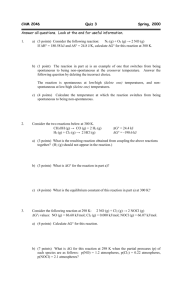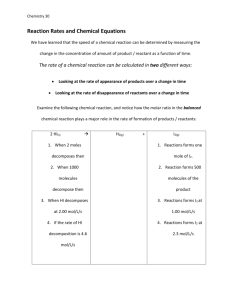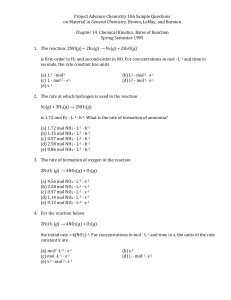1412-Home-work 2.doc
advertisement
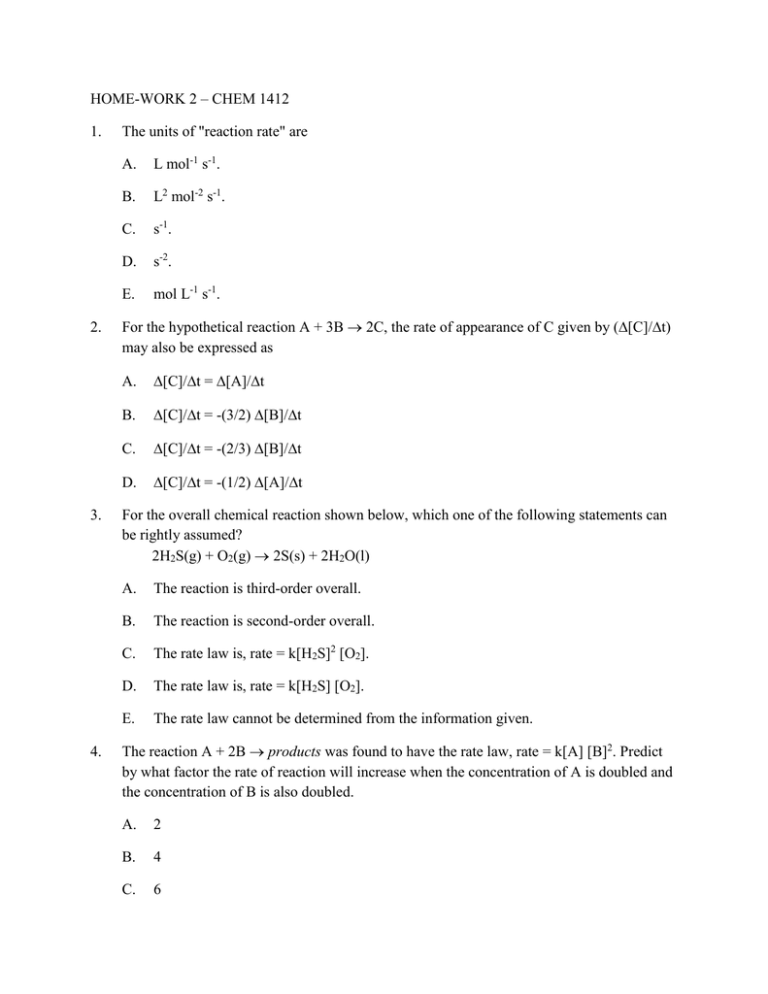
HOME-WORK 2 – CHEM 1412 1. 2. 3. 4. The units of "reaction rate" are A. L mol-1 s-1. B. L2 mol-2 s-1. C. s-1. D. s-2. E. mol L-1 s-1. For the hypothetical reaction A + 3B 2C, the rate of appearance of C given by ([C]/t) may also be expressed as A. [C]/t = [A]/t B. [C]/t = -(3/2) [B]/t C. [C]/t = -(2/3) [B]/t D. [C]/t = -(1/2) [A]/t For the overall chemical reaction shown below, which one of the following statements can be rightly assumed? 2H2S(g) + O2(g) 2S(s) + 2H2O(l) A. The reaction is third-order overall. B. The reaction is second-order overall. C. The rate law is, rate = k[H2S]2 [O2]. D. The rate law is, rate = k[H2S] [O2]. E. The rate law cannot be determined from the information given. The reaction A + 2B products was found to have the rate law, rate = k[A] [B]2. Predict by what factor the rate of reaction will increase when the concentration of A is doubled and the concentration of B is also doubled. A. 2 B. 4 C. 6 5. 6. D. 8 E. 9 It takes 42.0 min for the concentration of a reactant in a first-order reaction to drop from 0.45 M to 0.32 M at 25C. How long will it take for the reaction to be 90% complete? A. 13.0 min B. 86.0 min C. 137 min D. 222 min E. 284 min Nitric oxide gas (NO) reacts with chlorine gas according to the equation NO + ½Cl2 NOCl. The following initial rates of reaction have been measured for the given reagent concentrations. Which of the following is the rate law (rate equation) for this reaction? 7. A. rate = k[NO] B. rate = k[NO][Cl2]1/2 C. rate = k[NO][Cl2] D. rate = k[NO]2[Cl2] E. rate = k[NO]2[Cl2]2 Appropriate units for a second-order rate constant are A. M/s. B. 1/M·s. C. 1/s. D. 8. 1/M2·s. For the reaction X + Y Z, the reaction rate is found to depend only upon the concentration of X. A plot of 1/X verses time gives a straight line. What is the rate law for this reaction? A. rate = k [X] B. rate = k [X]2 C. rate = k [X][Y] D. rate = k [X]2[Y] 9. For a certain second-order decomposition reaction, the rate is 18.0 M/min when the concentration of the reactant is 0.20 M. What is the value of the rate constant (in L/mole-s) for this reaction ? a. b. c. d. e. 10. 0.67 1.5 2.2 3 7.5 Which of the following statements is false? A. A catalyst increases the rate of the forward reaction, but does not alter the reverse rate. B. A catalyst alters the mechanism of reaction. C. A catalyst alters the activation energy. 11. 12. D. A catalyst may be altered in the reaction, but is always regenerated. E. A catalyst increases the rate of reaction, but is not consumed. Peroxodisulfate ion can oxidize iodide ions to iodine according to the balanced equation S2O82- + 2I - 2SO42- + I2. The reaction is catalyzed by certain chemical species. Identify the catalyst in the following mechanism: A. Fe3+ B. I- C. S2O82- D. Fe2+ E. SO42- The following reaction in aqueous solution was found to be first order in [OH-], first order in [C2H5Br], and inverse first order in Br-. C2H5Br + OH- C2H5OH + BrWhich one of the following mechanisms is consistent with the observed reaction order? A. B. C. D. 13. For the chemical reaction system described by the diagram below, which statement is true? If the Ea for the forward reaction is 25 kJ/mol and the enthalpy of reaction is -95 kJ/mol, what is Ea for the reverse reaction? 14. A. 120 kJ/mol B. 70 kJ/mol C. 95 kJ/mol D. 25 kJ/mol E. -70 kJ/mol The activation energy for the following first-order reaction is 102 kJ/mol. N2O5(g) 2NO2(g) + (1/2)O2(g) The value of the rate constant (k) is 1.35 10-4 s-1 at 35C. What is the value of k at 0C? A. 8.2 10-7 s-1 B. 1.9 10-5 s-1 15. 16. 17. C. 4.2 10-5 s-1 D. 2.2 10-2 s-1 E. none of these For a second order reaction, the half-life is equal to A. t1/2 = 0.693/k. B. t1/2 = k/0.693. C. t1/2 = 1/k[A]o. D. t1/2 = k. E. t1/2 = [A]o/2k. At 25C, the second-order reaction NOCl(g) NO(g) + 1/2Cl2(g) is 50% complete after 5.82 hours when the initial concentration of NOCl is 4.46 mol/L. How long will it take for the reaction to be 75% complete? A. 8.22 hr B. 11.6 hr C. 15.5 hr D. 17.5 hr E. 23.0 hr The isomerization of cyclopropane to form propene is a first-order reaction. At 760 K, 85% of a sample of cyclopropane changes to propene in 79.0 min. Determine the rate constant for this reaction at 760 K. A. 3.66 10-2 min-1 B. 1.04 10-2 min-1 C. 2.42 min-1 18. D. 2.06 10-3 min-1 E. 2.40 10-2 min-1 The Arrhenius equation is k = A e-(Ea/RT). The slope of a plot of ln k vs. 1/T is equal to A. -k. B. k. C. Ea. D. -Ea /R. E. A. 19. Sucrose, C12H22O11, reacts slowly with water in the presence of an acid to form two other sugars, glucose and fructose, both of which have the same molecular formulas, but different structures. C12H22O11 + H2O C6H12O6 (glucose) + C6H12O6 (fructose) The reaction is first order and has a rate constant of 6.2 10-5 /s at 35C when the H+ concentration is 0.10 M. Suppose that the initial concentration of sucrose in the solution is 0.40 M. How many minutes will it take for the sucrose concentration to drop to 0.30 M? 20. Nitrogen pentoxide decomposes by a first-order process yielding N2O4 and oxygen. 2N2O5 2N2O4 + O2 At a given temperature, the half-life of N2O5 is 0.90 hr. What is the first-order rate constant for N2O5 decomposition?

